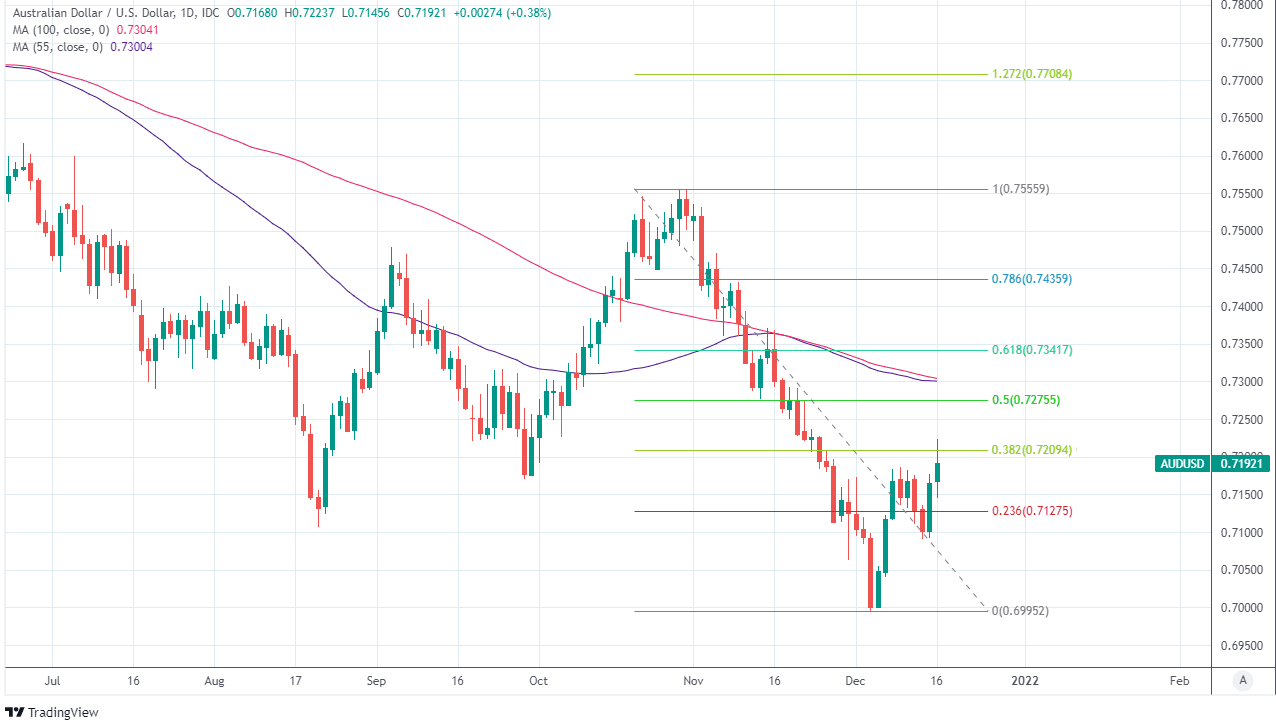Australian Dollar Could Benefit if RBA Follows Global Peers and Tightens Policy
- Written by: James Skinner
-
- AUD a likely beneficiary of global central bank shift
- If Fed, BoE, ECB action draws RBA policy shift also
- Global picture, AU jobs & CPI all key for RBA policy
- RBA Gov & AU job data suggest QE may end in Feb

Image © Newtown Grafitti, Reproduced under CC Licensing.
The Australian Dollar could be in line to benefit further after its stars appeared to align in suggestion that a February change in the Reserve Bank of Australia’s (RBA) monetary policy may be growing likely.
Australia’s Dollar reached December highs against the U.S. Dollar Thursday and even managed to stem the advance of a buoyant Pound Sterling that had been lifted almost across the board by a surprise Bank of England (BoE) decision to lift Bank Rate from 0.1% to 0.25%.
The antipodean currency was bought after the Australian Bureau of Statistics said the country’s unemployment rate fell more than 60 basis points to 4.6% in November following a blockbuster 366.1k increase in the number of jobs created or recovered from the coronavirus.
That leaves the jobless rate close to its 2021 low of 4.5%, which was also its lowest since before the global financial crisis, and takes the RBA a step closer to the “much tighter labour market” and sufficient wage pressures thought necessary to sustainably achieve the 2.5% inflation target.
“Today’s speech by RBA Governor Lowe on The RBA and the Australian Economy, sets up an end to quantitative easing (QE) in February, absent a big hit to the economy from Omicron,” says Felicity Emmett, an economist at ANZ, in a Thursday note.
Above: GBP/AUD shown at daily intervals alongside AUD/USD.
- GBP/AUD reference rates at publication:
Spot: 1.8589 - High street bank rates (indicative band): 1.7938-1.8069
- Payment specialist rates (indicative band): 1.8460-1.8490
- Find out about specialist rates, here
- Set up an exchange rate alert, here
- Book your ideal rate, here
Thursday’s jobs data is potentially supportive of the Australian Dollar in part because Governor Philip Lowe had said in an earlier speech that stronger-than-expected figures are among the factors that could lead the RBA to curtail its quantitative easing programme in February.
“Much will depend upon the news we receive between now and when we meet in February. Importantly, we will receive further readings on inflation and the strength of the labour market (including the labour force survey later this morning),” Governor Lowe said on Thursday.
“If better-than-expected progress towards the Board's goals was made, then the case to cease bond purchases in February would be stronger,” Lowe also said, speaking in an address to the CPA Australia Riverina Forum.
Progress toward the RBA’s employment and inflation objectives was also cited by Governor Lowe and in December’s RBA policy decision as one of three things that would determine the February decision on what to do about the bank’s A$4BN per week bond buying programme.
Aussie inflation rose to 3% in October and above the RBA’s target, while earlier this month it emerged that the fall in third-quarter economic output resulting from renewed ‘lockdown’ was -1.9%, which was smaller than both the RBA and market had anticipated.
{wbamp-hide start} {wbamp-hide end}{wbamp-show start}{wbamp-show end}
These data addressed key uncertainties faced by the RBA, although the path toward a February curtailment of its QE programme may have been cleared further on Thursday by the actions of other central banks.
Those were also cited by Governor Lowe as key in determining the future of the bank’s bond buying programme, while on Thursday the BoE, Federal Reserve and European Central Bank were just a few of those who announced actions that curbed the amount of policy support provided to economies.
Should the RBA follow in the footsteps of other central banks it could prove supportive of the Aussie in the short-term, although some analysts doubt that any forthcoming changes in RBA policy would be enough for the antipodean to sustain a rebound against the Dollar, Pound and some others.
“If the December survey is also robust and core CPI surprises to the strong side, then the Aussie should rebound steeply in anticipation of a substantial hawkish turn by the RBA in February. But our base case is that the RBA continues to expect only a gradual rise in wages and inflation, such that it pushes back on markets eager to price in rate hikes from mid-2022,” says Sean Callow, a senior FX strategist at Westpac.
“This would leave the RBA with limited company among major central banks starting 2022 with no urgency to raise rates (along with BoJ and ECB). This should help keep a lid on AUD/USD rallies, with our March forecast just 0.7100. A$’s commodity price support should continue to trend lower, though trade surpluses remain likely for some time, limiting the pressure on the Aussie at times of risk aversion,” Callow also said.
Above: AUD/USD at daily intervals with Fibonacci retracements of October fall and major moving-averages indicating likely areas of technical resistance.












